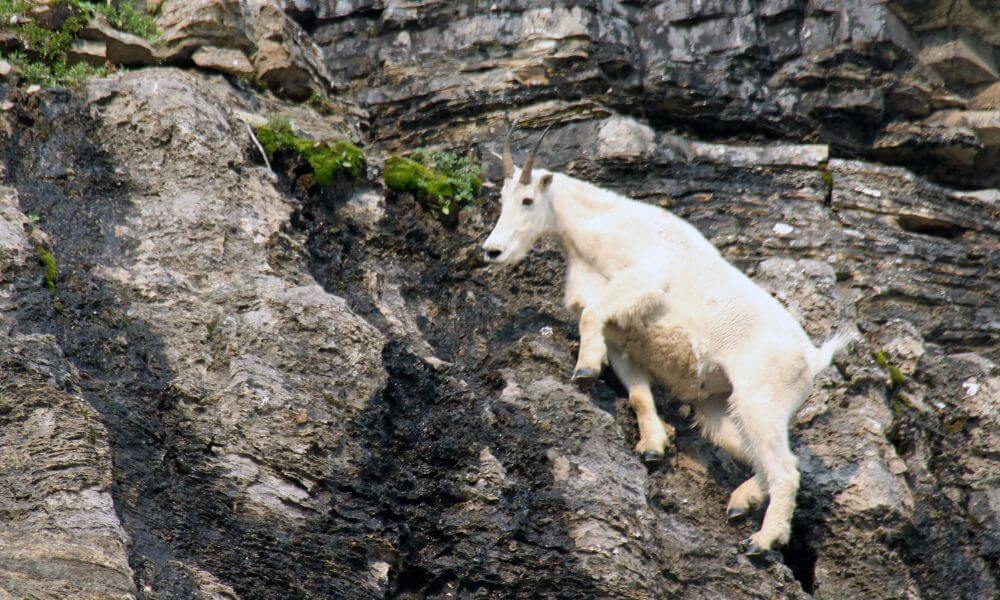Mountain goats are a rare species of goat-antelope exclusively found in the mountains of the North American continent.
They live at heights up to 13,000 feet on the slopes of alpine mountains as they search for food and seek protection from predators.
Mountain goats are large, standing at over 3 feet (1 meter) at the shoulder and weighing between 180 and 380 pounds (80 and 170 kilograms) depending on sex and age.

What should you do if you meet a mountain goat?
When hiking in the beautiful mountain ranges of North America, you’re sure to spot some wildlife while navigating the trails.
While mountain goats are usually human-averse and shy, you might still come across one.
If you ever do encounter a mountain goat, it’s best to keep your distance.
If the mountain goat sees you and doesn’t run away, then it means it is either curious, unworried, or may even feel threatened.
Here’s what to do if you meet a mountain goat:
- Do not approach the mountain goat. Pass them by, keeping at least 50 yards (45 meters) between you and the mountain goat. Start backing away from it if you can’t pass it by at a distance. If it’s a nannie with her kids, you should be extra careful to not take any threatening actions.
- Shout loudly and wave your arms to scare the mountain goat off if it starts approaching you. If they still keep approaching, throw rocks at them (don’t worry, it won’t hurt much if it hits them, they have thick fur).
- Try to move to a safer area where there are more humans or buildings. Always keep your eye on the animal and make it clear that you are leaving.
- If it starts charging toward you, run. Mountain goats are not predators and don’t have a hunter-prey trigger, so you should run if none of the previous options work. They may give chase and can run faster than you can, but will usually give up quickly.
- If all else fails and you’re face to face with a mountain goat, turn to it and grab it by the horns when it gets close. Gaining control of their only weapon is your best bet to avoiding injury until someone can come to help you. They will try to whip their head around, but most humans will be strong enough to hang on.
How can you avoid mountain goats?
Unfortunately, mountain goats have learned over the years that humans aren’t a threat to them and will often stand their ground when they see you.
The best way to avoid them is to ensure you don’t attract them in the first place.
Mountain goats will approach humans because they have learned that humans and their equipment can have sweat, which is a very tempting source of salts and minerals.
Never leave your sweaty gear or clothing lying around.
Don’t urinate on the trail. Instead, get at least 50 yards (45 meters) from the trail first.
If a mountain goat approaches you or your kit, make sure you remember what to do.
Remember to never feed mountain goats and never treat them like pets.
They are wild animals, and while they may seem friendly at times, it will never be to your benefit to interact with them.
Can mountain goats kill humans?
Yes, mountain goats can certainly kill humans.
They have been known to fight off predators such as wildcats and bears, which are larger and stronger than humans.
Fights often break out among mountain goats over hierarchy and territory, ensuring that these creatures are always fit for a fight.
Mountain goats don’t fight like typical goats; instead, they use their sharp horns to stab and slash their opponents.
A mountain goat’s long, sharp horns on its head are used as its primary weapon.
These horns can be up to 10 inches (25 centimeters) long and are wielded with great skill, making it possible for them to kill a human with a single slash.
There has only been one recorded incident of a mountain goat killing a human.
In 2010, a 63-year-old hiker at the Olympic National Park was gored to death without provocation by a particularly aggressive mountain goat.
Park rangers had attempted to make the individual mountain goat scared of humans before but had to kill it after this incident.
What makes mountain goats aggressive?
Mountain goats are typically not aggressive against anything unless it provokes or threatens them.
They are not predators and usually won’t seek out another animal or human to harm or kill it.
Mountain goats are still unpredictable as many wild animals are, and will attack if they feel trapped or threatened (even if you’re trying not to threaten them).
Nannies with their young kids are especially on edge.
While you’re a lot less likely to encounter them (since the nannies keep away from anything that may be dangerous), you should always assume that her first instinct will be to assume you’re a danger to her kids.
Move away as quickly as possible.
Herbivores like mountain goats are rarely infected by rabies, but it’s always possible.
Rabies makes an animal extremely aggressive and unpredictable.
If a mountain goat suspects you to be an opponent (another mountain goat buck), they may also attack.
Both bucks and nannies can be territorial and if they mistake you to be a threat they will likely attack.
That’s why it’s a good idea to move away if you see one.
While mountain goats may seem like fluffy and friendly friends, they’re not like your typical goats back home.
Always assume they are dangerous and give them a wide berth if you ever see one.
You’re likely not in danger, but it’s best to stay safe by avoiding them.
